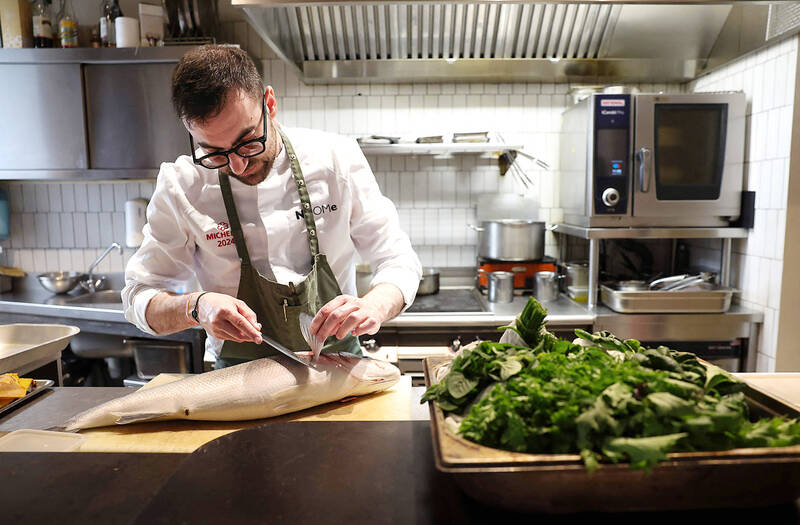At the annual gathering of France’s finest chefs for the Michelin Guide awards this year, the talk was not only about whose restaurants had gained or lost a star.
“Everyone’s discussing AI [artificial intelligence]. I was at a table of 12 other chefs, and it was the main thing we talked about,” Matan Zaken, who runs the one-star Nhome restaurant in Paris, said at the event at the end of March.
The 32-year-old believes that some of his peers are reluctant to admit just how much they are already consulting services such as ChatGPT to help them with recipes and ideas.

Photo: AFP
“You’d be amazed to know how many people are using it. There are a lot of egos in the business. They’re not going to make a big thing about it,” he said.
Zaken has made a point of openly embracing the technology, which he said has the potential to produce surprising new pairings of ingredients, offering the possibility of palate-twisting discoveries for diners.
“You have to move with the times,” said the Franco-Israeli owner of the intimate 20-cover Nhome, where guests eat around a large communal table.
Instead of relying on his usual kitchen tasting books, he can now access vast online databases of food photographs, recipes and even the chemical analysis of food molecules.
One recent discovery thanks to ChatGPT Premium, which he says is starting to learn his cooking style, was the complementarity between peanuts and wild garlic. He has joined forces with French digital art collective Obvious Art.
The group provided Zaken with a series of AI-generated photographs of food on plates, and he was required to come up with meals that were served at a private event.
This reversed the usual creative cooking process which begins with the ingredients.
Not everyone is so enthusiastic about the new technology in the kitchen.
Although the high-end cooking jobs are seen as relatively insulated from the arrival of AI — unlike other industries — the idea of computers helping with, or even replacing, the creative process makes some chefs uneasy.
“Artificial intelligence will never replace the human touch, the palate of the cook,” said French celebrity chef Philippe Etchebest, who was toasting a second star for his Bordeaux eatery, Maison Nouvelle, at the Michelin event.
“Artificial intelligence can replace humans elsewhere, but in the kitchen, I don’t believe it will at all,” Etchebest said.
For others, computers and new technology run counter to the vision of kitchens as an artisanal workplace, based on human-to-human transmission and cooking that is rooted in local tradition and produce.
“It’s not really in the spirit of our business,” said Thibaut Spiwack, a young chef who runs Anona, an eco-friendly one-star restaurant in Paris that sources all its produce from the capital region.
“My intelligence is in these,” said Thierry Bridron, a pastry chef and head of the Valrhona cooking school, holding up his hands at an after-party at the Michelin awards.
“There’s nothing more beautiful than nature and what grows,” Bridron said.
Whatever their views on AI in the creative process, many appeared ready to embrace ChatGPT and other AI services to relieve them of tedious work, such as writing e-mails, job advertisements or producing kitchen rotas. New phone-based apps such as Menu or Fullsoon offer more, enabling users to enter recipes and then have instant estimates of cost or the carbon footprint of their dishes. By using data on past purchases and billing, some existing services can help restaurants predict demand, sometimes by integrating factors such as weather and the dates of local sports events. Raphael Haumont, a food chemistry expert at Paris Saclay University and cofounder of the French Center of Culinary Innovation, believes the biggest changes would be on the plate.
Advanced databases of food ingredients containing details about the molecules that produce the aromas and tastes we enjoy could help produce surprising new pairings, Haumont said.
“Perhaps the computer can find things in common that are completely unexpected. For example, chocolate and cucumber. We know now that it works,” Haumont said.
AI-augmented software can also analyze hundreds of thousands of cookbooks, while suggesting new ways to produce or plate food.
“It can analyze 10,000 images of plated langoustine, for example, and say: ‘The next one could look like that. Be inspired,’” he added.
In his techno-utopian vision of the future, high-precision robots might even do some of the most thankless kitchen tasks for an industry that is perennially short of workers.
“Who wants to peel potatoes for two hours?” he asked.

Taiwan Semiconductor Manufacturing Co (TSMC, 台積電) last week recorded an increase in the number of shareholders to the highest in almost eight months, despite its share price falling 3.38 percent from the previous week, Taiwan Stock Exchange data released on Saturday showed. As of Friday, TSMC had 1.88 million shareholders, the most since the week of April 25 and an increase of 31,870 from the previous week, the data showed. The number of shareholders jumped despite a drop of NT$50 (US$1.59), or 3.38 percent, in TSMC’s share price from a week earlier to NT$1,430, as investors took profits from their earlier gains

In a high-security Shenzhen laboratory, Chinese scientists have built what Washington has spent years trying to prevent: a prototype of a machine capable of producing the cutting-edge semiconductor chips that power artificial intelligence (AI), smartphones and weapons central to Western military dominance, Reuters has learned. Completed early this year and undergoing testing, the prototype fills nearly an entire factory floor. It was built by a team of former engineers from Dutch semiconductor giant ASML who reverse-engineered the company’s extreme ultraviolet lithography (EUV) machines, according to two people with knowledge of the project. EUV machines sit at the heart of a technological Cold

AI TALENT: No financial details were released about the deal, in which top Groq executives, including its CEO, would join Nvidia to help advance the technology Nvidia Corp has agreed to a licensing deal with artificial intelligence (AI) start-up Groq, furthering its investments in companies connected to the AI boom and gaining the right to add a new type of technology to its products. The world’s largest publicly traded company has paid for the right to use Groq’s technology and is to integrate its chip design into future products. Some of the start-up’s executives are leaving to join Nvidia to help with that effort, the companies said. Groq would continue as an independent company with a new chief executive, it said on Wednesday in a post on its Web

CHINA RIVAL: The chips are positioned to compete with Nvidia’s Hopper and Blackwell products and would enable clusters connecting more than 100,000 chips Moore Threads Technology Co (摩爾線程) introduced a new generation of chips aimed at reducing artificial intelligence (AI) developers’ dependence on Nvidia Corp’s hardware, just weeks after pulling off one of the most successful Chinese initial public offerings (IPOs) in years. “These products will significantly enhance world-class computing speed and capabilities that all developers aspire to,” Moore Threads CEO Zhang Jianzhong (張建中), a former Nvidia executive, said on Saturday at a company event in Beijing. “We hope they can meet the needs of more developers in China so that you no longer need to wait for advanced foreign products.” Chinese chipmakers are in